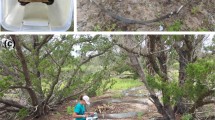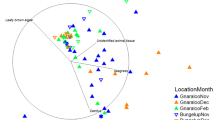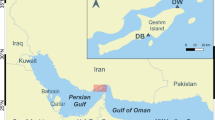Abstract
Geophagy is the consumption of hard objects with no caloric value (e.g. soil, sand, sediment) called gastroliths. This behaviour is widespread in animals, and among reptiles, geophagy has been reported in crocodilians and lizards and occasionally in chelonians. In this study, we calculated geophagy rates in snapping turtle (Chelydra serpentina) and painted turtle (Chrysemys picta) hatchlings under various incubation protocols, ranging from highly artificial to semi-natural conditions. Among multiple experiments where eggs were incubated atop the nesting substrate, 66% of painted turtle and 58–93% of snapping turtle hatchlings exhibited geophagy within 24 h of hatching. Snapping turtle hatchlings that experienced a simulated natural nest emergence had an 85–100% rate of gastrolith consumption. Hatchling snapping turtles from shallow simulated nests emerged earlier and had higher rates of geophagy compared with those from deeper nests. Given the high frequency, short time period (24~72 h) and variety of incubation protocols under which geophagy occurred, we suggest that this behaviour is intentional. We discuss multiple hypothesis for the adaptive and functional significance of geophagic behaviour with respect to chelonians, synthesize existing literature on chelonian geophagy and highlight the possible implications of hatchling turtle geophagy for ex situ captive breeding and head-starting programs. Given that hatchlings readily consume their incubation medium, caretakers should carefully consider the substrate their animals are exposed to. Future research should address how widespread geophagy is among hatchling turtles and the possible role of this behaviour for hatchling ecology and health, including effects on the gut microbiome.
Significance statement
Animals regularly consume non-caloric foods, such as rocks and soils. This behaviour is exhibited by hatchling turtles, but why? Our literature review suggests that the ingestion of non-caloric foods by turtles is important for nutrition and, in particular, this behaviour may help establish gut health in hatchlings. Observational and experimental study demonstrated that nest characteristics in-part account for why hatchling ‘turtles eat dirt’. This has applications for hatchling ecology as well as captive rearing conservation programs, an increasingly common strategy for the conservation of these globally imperilled animals. This work complements several recent studies and review articles about geophagy in other major vertebrate groups (birds, mammals) and provides a comprehensive summary on the current state of knowledge of this behaviour for turtles.


Similar content being viewed by others
Data availability
Data will be made available upon reasonable request to the authors.
References
Bally P (1946) Tortoises eating bones. East Afr Uganda Nat Hist Soc 18:163
Bar-tal A, Saha UK, Raviv M, Tuller M (2019) Inorganic and synthetic organic component of soilless culture and potting mixes. In: Raviv M, Lieth JH, Bar-tal A (eds) Soilless culture: theory and practice, 2nd edn. Academic Press, San Diego, pp 259–301. https://doi.org/10.1016/B978-0-444-63696-6.00007-4
Bates D, Maechler M, Bolker B, Walker S (2015) Fitting linear mixed-effects models using lme4. J Stat Softw 67:1–48
Bennett AM, Steiner J, Carstairs S, Gielens A, Davy CM (2017) A question of scale: replication and the effective evaluation of conservation interventions. FACETS 2:893–909. https://doi.org/10.1139/facets-2017-0010
Beyer WN, Conner EE, Gerould S (1994) Estimates of soil ingestion by wildlife. J Wildl Manag 58:375–382 https://www.jstor.org/stable/3809405
Bobyn ML, Brooks RJ (1994) Interclutch and interpopulation variation in the effects of incubation conditions on sex, survival and growth of hatchling turtles (Chelydra serpentina). J Zool 233:233–257. https://doi.org/10.1111/j.1469-7998.1994.tb08586.x
Bramble DM (1973) Media dependent feeding in turtle. Am Zool 13:1342
Bramble DM, Wake DB (1985) Feeding mechanisms of lower tetrapods. In: Hildebrand M, Bramble DM, Leim KF, Wake DB (eds) Functional vertebrate morphology. Harvard University Press, Cambridge, pp 230–261
Burke RL (2015) Head-starting turtles: learning from experience. Herpetol Conserv Biol 10:299–308
Bush AL (2001) Construction materials: lightweight aggregates. In: Buschow KHJ, Cahn RW, Flemings MC, Ilschner B, Kramer EJ, Mahajan S, Veyssière P (eds) Encyclopedia of materials: science and technology, 2nd edn. Elsevier Ltd, Amsterdam, pp 1550–1558. https://doi.org/10.1016/B0-08-043152-6/00277-1
Costanzo JP, Litzgus JD, Lee RE Jr (1999) Behavioral responses of hatchling painted turtles (Chrysemys picta) and snapping turtles (Chelydra serpentina) at subzero temperatures. J Therm Biol 24:161–166. https://doi.org/10.1016/S0306-4565(99)00006-6
Costanzo JP, Baker PJ, Dinkelacker SA, Lee RE Jr (2003) Endogenous ice-nucleating agents constrain supercooling in the hatchling painted turtle. J Exp Biol 206:477–485. https://doi.org/10.1242/jeb.00112
Costanzo JP, Baker PJ, Lee RE Jr (2006) Physiological responses to freezing in hatchlings of freeze-tolerant and -intolerant turtles. J Comp Physiol B 176:697–707. https://doi.org/10.1007/s00360-006-0092-9
Costanzo JP, Lee RE Jr, Ultsch GR (2008) Physiological ecology of overwintering in hatchling turtles. J Exp Zool 309A:297–379. https://doi.org/10.1002/jez.460
Delmas V, Bonnet X, Girondot M, Prévot-Julliard A-C (2008) Varying hydric conditions during incubation influence egg water exchange and hatchling phenotype in the red-eared slider turtle. Physiol Biochem Zool 81:345–355. https://doi.org/10.1086/529459
Downs CT, Bredin IP, Wragg PD (2019) More than eating dirt: a review of avian geophagy. Afr Zool 54:1–19. https://doi.org/10.1080/15627020.2019.1570335
Edge CB, Rollinson N, Brooks RJ, Congdon JD, Janzen FJ, Litzgus JD (2017) Phenotypic plasticity of nest timing in a post-glacial landscape: how do reptiles adapt to seasonal time constraints. Ecology 98:512–524. https://doi.org/10.1002/ecy.1665
Edgren RA (1960) A seasonal change in bone density in female musk turtles, Sternothaerus odoratus (Latreille). Comp Biochem Physiol 1:213–217. https://doi.org/10.1016/0010-406X(60)90024-4
Ehrenfeld DW (1979) Behavior associated with nesting. In: Harless M, Morlock H (eds) Turtles: perspectives and research. John Wiley & Sons, New York, pp 417–434
Esque TC, Peters EL (1994) Ingestion of bones, stones and soil by desert tortoises. In: Bury RB, Germano DJ (eds) Biology of North American tortoises. Fish and wildlife research, vol. 13. U.S. Department of Interior National Biological Survey, Washington, DC, pp. 105–112
Francis EA, Moldowan PD, Greischar MA, Rollinson N (2019) Anthropogenic nest sites provide warmer incubation temperatures than natural nest sites in a population of oviparous reptiles near their northern range limit. Oecologia 190:511–522. https://doi.org/10.1007/s00442-019-04383-3
Gagno S, Alotto C (2010) Géophagie chez la Tortue d’Hermann, Testudo hermanni Gmelin, 1789 (Chelonii, Testudinidae), dans la region des Maures (Var, France). Bull Soc Herpétol France 135-136:23–32
Gilardi JD, Duffey SS, Munn CA, Tell L (1999) Biochemical functions of geophagy in parrots: detoxification of dietary toxins and cytoprotective effects. J Chem Ecol 25:897–922. https://doi.org/10.1023/A:1020857120217
Hasan HAH (2000) Ureolytic microorganisms and soil fertility: a review. Commun Soil Sci Plan 31:2565–2589. https://doi.org/10.1080/00103620009370609
Henderson DM (2003) Effects of stomach stones on the buoyancy and equilbrium of a floating crocodilian: a computational analysis. Can J Zool 81:1346–1357. https://doi.org/10.1139/z03-122
Henderson DM (2006) Floating point: a computation study of buoyancy, equilibrium, and gastroliths in plesiosaurs. Lethaia 39:227–244
Holgersson MCN, Nichols WA, Paitz RT, Bowden RM (2016) How important is the eggshell as a source for initial acquisition of Salmonella in hatchling turtles? J Exp Zool 325:142–148
Hui CA (2004) Geophagy and potential contaminant exposure for terrestrial vertebrates. In: Ware GW (ed) Reviews of environmental contamination and toxicology. Springer, New York, pp 115–134
Iverson JB (1982) Ontogenetic changes in relative skeletal mass in the painted turtle Chrysemys picta. J Herpetol 16:412–414 https://www.jstor.org/stable/1563575
Iverson JB (1984) Proportional skeletal mass in turtles. Florida Sci 47:1–11 https://www.jstor.org/stable/24320283
Janzen FJ, Hoekstra LA, Brooks RJ, Carroll DM, Gibbons JW, Greene JL, Iverson JB, Litzgus JD, Michael ED, Parren SG, Roosenburg WM, Strain GF, Tucker JK, Ultsch GR (2018) Altered spring phenology of North American freshwater turtles and the importance of representative populations. Ecol Evol 8:5815–5827. https://doi.org/10.1002/ece3.4120
Klaus G, Schmidg B (1998) Geophagy at natural licks and mammal ecology: a review. Mammalia 62:482–497. https://doi.org/10.1515/mamm.1998.62.4.482b
Klein N, Frohlich F, Krief S (2008) Geophagy: soil consumption enhances the bioactivities of plants eaten by chimpanzees. Naturwissenschaften 95:325–331. https://doi.org/10.1007/s00114-007-0333-0
Knezevich M (1998) Geophagy as a therapeutic mediator of endoparasitism in a free-ranging group of rhesus macaques (Macaca mulatta). Am J Primatol 44:71–82. https://doi.org/10.1002/(SICI)1098-2345(1998)44:1<71::AID-AJP6>3.0.CO;2-U
Kreulen DA (1985) Lick use by large herbivores: a review of benefits banes of soil consumption. Mammal Rev 15:107–123
Krishnamani R, Mahaney WC (2000) Geophagy among primates: adaptive significance and ecological consequences. Anim Behav 59:899–915. https://doi.org/10.1006/anbe.1999.1376
Kuznestsova A, Brockhoff PB, Christensen RHB (2017) lmerTest package: tests in linear mixed effects models. J Stat Softw 82:1–26
Lance VA, Morafka DJ (2001) Post natal lecithotrophy: a new age class in the ontogeny of reptiles. Herpetol Monogr 15:124–134. https://doi.org/10.2307/1467040
Legler JM (1954) Nesting habits of the western painted turtle, Chrysemys picta bellii (Gray). Herpetologica 10:137–144 https://www.jstor.org/stable/20171330
Legler JM (1960) Natural history of the ornate box turtle, Terrapene ornata ornata Agassiz. Univ Kansas Publ, Mus Nat Hist 11:527–669
Lloyd AB, Sheaffe MJ (1973) Urease activity in soils. Plant Soil 39:71–80. https://doi.org/10.1007/BF00018046
MacDonald LA, Mushinsky HR (1988) Foraging ecology of the gopher tortoise, Gopherus polyphemus, in sandhill habitat. Herpetologica 44:345–353 https://www.jstor.org/stable/3892350
Marlow RW, Tollestrup K (1982) Mining and exploitation of natural mineral deposit by the desert tortoise, Gopherus agassizii. Anim Behav 30:475–478. https://doi.org/10.1016/S0003-3472(82)80058-4
Massey MD, Holt SM, Brooks RJ, Rollinson N (2019) Measurement and modelling of primary sex ratios in species with temperature-dependent sex determination. J Exp Biol 222:jeb190215. https://doi.org/10.1242/jeb.190215
McGehee MA (1990) Effects of moisture on eggs and hatchlings of loggerhead sea turtles (Caretta caretta). Herpetologica 46:251–258 https://www.jstor.org/stable/3892967
Meylan A (1988) Spongivory in hawksbill turtles: a diet of glass. Science 239:394–395. https://doi.org/10.1126/science.239.4838.393
Milton SJ (1992) Plants eaten and dispersed by adult leopard tortoises Geochelone pardalis (Reptilia: Chelonii) in the southern Karoo. S Afr J Zool 27:45–49. https://doi.org/10.1080/02541858.1992.11448261
Moldowan PD, Keevil MG, Mills PB, Brooks RJ, Litzgus JD (2015) Diet and feeding behaviour of snapping turtles (Chelydra serpentina) and midland painted turtles (Chrysemys picta marginata) in Algonquin Provincial Park, Ontario. Can Field-Nat 129:403–408. https://doi.org/10.22621/cfn.v129i4.1764
Moore JA, Dornburg A (2014) Ingestion of fossil seashells, stones and small mammal bones by gravid gopher tortoises (Gopherus polyphemus) in Florida. Bull Peabody Mus Nat Hist 55:55–63. https://doi.org/10.3374/014.055.0105
Obbard ME, Brooks RJ (1981) Fate of overwintered clutches of the common snapping turtle (Chelydra serpentina) in Algonquin Park, Ontario. Can Field-Nat 95:350–352
Packard GC, Packard MJ (1990) Patterns of survival at subzero temperatures by hatchling painted turtles and snapping turtles. J Exp Zool 254:233–236. https://doi.org/10.1002/jez.1402540216
Packard GC, Packard MJ (2003a) Influence of acclimation and incubation medium on supercooling by hatchling painted turtles, Chrysemys picta. Funct Ecol 17:611–618. https://doi.org/10.1046/j.1365-2435.2003.00780.x
Packard GC, Packard MJ (2003b) Natural freeze-tolerance in hatchling painted turtles? Comp Biochem Physiol 134:233–246. https://doi.org/10.1016/S1095-6433(02)00264-7
Packard GC, Packard MJ (2006) The relationship between gut contents and supercooling capacity in hatchling painted turtles (Chrysemys picta). Comp Biochem Physiol 144:98–104. https://doi.org/10.1016/j.cbpa.2006.02.010
Packard GC, Ruble KA, Packard MJ (1993) Hatchling snapping turtles overwintering in natural nests are inoculated by ice in frozen soil. J Therm Biol 18:185–188. https://doi.org/10.1016/0306-4565(93)90001-A
Packard GC, Packard MJ, Birchard GF (2000) Availability of water affects organ growth in prenatal and neonatal snapping turtles (Chelydra serpentina). J Comp Physiol B 170:69–74. https://doi.org/10.1007/s003600050009
Packard GC, Packard MJ, McDaniel LL (2001) Seasonal change in the capacity for supercooling by neonatal painted turtles. J Exp Biol 204:1667–1672
Panichev AM, Golokhvast KS, Gulkov AN, Chekryzhov IY (2013) Geophagy in animals and geology of kudurs (mineral licks): a review of Russian publications. Environ Geochem Health 35:133–152. https://doi.org/10.1007/s10653-012-9464-0
Patterson R (1971) The role of urination in egg predator defense in the desert tortoise (Gopherus agassizi). Herpetologica 27:197–199 https://www.jstor.org/stable/3891078
R Core Team (2020) R: a language and environment for statistical computing. R Foundation for Statistical Computing, Vienna, Austria, https://www.r-project.org/
Rhodin AGJ (1974) Pathological lithophagy in Testudo horsfieldi. J Herpetol 8:385–386
Riley JL, Tattersall GJ, Litzgus JD (2014) Potential sources of intra-population variation in overwintering strategy of painted turtle (Chrysemys picta) hatchlings. J Exp Biol 217:4174–4183. https://doi.org/10.1242/jeb.111120
Robinson SA, Forbes MR, Hebert CE (2008) Is the ingestion of small stones by double-crested cormorants a self-medication behavior? Condor 110:782–785. https://doi.org/10.1525/cond.2008.8541
Rollinson N, Brooks RJ (2008) Sources and significance of among-individual reproductive variation in a northern population of painted turtles (Chrysemys picta). Copeia 2008:533–541. https://doi.org/10.1643/CE-06-203
Schwarzkopf L, Brooks RJ (1985) Sex determination in northern painted turtles: effects of incubation at constant and fluctuating temperatures. Can J Zool 63:2543–2547. https://doi.org/10.1139/z85-378
Singh BK, Nunan N, Millard P (2009) Response of fungal, bacterial and ureolytic communities to synthetic sheep urine deposition in a grassland soil. FEMS Microbiol Ecol 70:109–117. https://doi.org/10.1111/j.1574-6941.2009.00731.x
Slabach BL, Corey TB, Aprille JR, Starks PT, Dane B (2015) Geophagic behavior in the mountain goat (Oreamnos americanus): support for meeting metabolic demands. Can J Zool 93:599–604. https://doi.org/10.1139/cjz-2015-0067
Sokol OM (1971) Lithophagy and geophagy in reptiles. J Herpetol 5:69–71. https://doi.org/10.2307/1562853
Stayton CT (2011) Terrestrial feeding in aquatic turtles: environment-dependent feeding behavior modulation and the evolution of terrestrial feeding in Emydidae. J Exp Biol 214:4083–4091. https://doi.org/10.1242/jeb.060574
Stitt EW, Davis C (2003) Gopherus agassizii (desert tortoise). Caliche mining. Herpetol Rev 37:77–78
Stone MD (2009) Effects of season, sex, and age on the calcium physiology and bone dynamics of turtles. Dissertation, Oklahoma State University
Storey KB, Storey JM, Brooks SP, Churchill TA, Brooks RJ (1988) Hatchling turtles survive freezing during winter hibernation. Proc Natl Acad Sci USA 85:8350–8354. https://doi.org/10.1073/pnas.85.21.8350
Sullivan BK, Cahill TM (2019) Seasonal timing of consumption of calcium-rich caliche in the Sonoran Desert tortoise (Gopherus morafkai) in central Arizona. Chelonian Conserv Biol 18:98–101. https://doi.org/10.2744/CCB-1339.1
Taylor MA (1993) Stomach stones for feeding or buoyancy? The occurrence and function of gastroliths in marine tetrapods. Philos Trans R Soc B 341:163–175. https://doi.org/10.1098/rstb.1993.0100
Turtle Conservation Coalition [Stanford CB, Rhodin AGJ, van Dijk PP et al (eds)] (2018) Turtles in Trouble: The World’s 25+ Most Endangered Tortoises and Freshwater Turtles—2018. IUCN SSC Tortoise and Freshwater Turtle Specialist Group, Turtle Conservancy, Turtle Survival Alliance, Turtle Conservation Fund, Chelonian Research Foundation, Conservation International, Wildlife Conservation Society, and Global Wildlife Conservation, Ojai, CA
Turtle Taxonomy Working Group (2017) Turtles of the world: annotated checklist and atlas of taxonomy, synonymy, distribution, and conservation status, 8th edn. In: Rhodin AGJ, Iverson JB, van Dijk PP, Saumure RA, Buhlmann KA, Pritchard PCH, Mittermeier RA (eds) Conservation biology of freshwater turtles and tortoises: a compilation project of the IUCN/SSC Tortoise and Freshwater Turtle Specialist Group. Chelonian Res Monogr 7:1–292. https://doi.org/10.3854/crm.7.checklist.atlas.v8.2017
Ultsch GR (2006) The ecology of overwintering among turtles: where turtles overwinter and its consequences. Biol Rev 81:339–367. https://doi.org/10.1017/S1464793106007032
Uriona TJ, Lyon M, Farmer CG (2019) Lithophagy prolongs voluntary dives in American alligators (Alligator mississippiensis). Integr Org Biol 1:oby008. https://doi.org/10.1093/iob/oby008
Walde AD, Delaney DK, Harless ML, Pater LL (2007) Osteophagy by the desert tortoise (Gopherus agassizii). Southwest Nat 52:147–149 https://www.jstor.org/stable/20424802
Warwick C, Arena P, Lindley S, Jessop M, Steedman C (2013) Assessing reptile welfare using behavioural criteria. InPractice 35:123–131. https://doi.org/10.1136/inp.f1197
Weibler JM, Kohl KD, Lee RE, Costanzo JP (2018) Urea hydrolysis by gut bacteria in a hibernating frog: evidence for urea-nitrogen recycling in Amphibia. Proc R Soc B 285:20180241. https://doi.org/10.1098/rspb.2018.0241
Whittle CH, Everhart MJ (2000) Apparent and implied evolutionary trends in lithophagic vertebrates from New Mexico and elsewhere. In: Lucas SG, Heckert AB (eds) Dinosaurs of New Mexico. New Mexico Mus Nat Hist Sci Bull No. 17, Albuquerque, NM, pp 75–82
Wings O (2007) A review of gastrolith function with implication for fossil vertebrates and a revised classification. Acta Palaeontol Pol 52:1–16
Worker SB, Kielland K, Barboza PS (2015) Effects of geophagy on food intake, body mass, and nutrient dynamics of snowshoe hare (Lepus americanus). Can J Zool 93:323–329. https://doi.org/10.1139/cjz-2014-0237
Yntema CL (1968) A series of stages in the embryonic development of Chelydra serpentina. J Morphol 125:219–252. https://doi.org/10.1002/jmor.1051250207
Acknowledgements
We are grateful to JD Litzgus and RJ Brooks for collaboration on turtle studies in Algonquin Provincial Park. We thank the Algonquin Wildlife Research Station for accommodation and logistical support as well as Algonquin Provincial Park and Ontario Parks for permissions and continued support of long-term study. One anonymous reviewer, JP Costanzo, and AD Watkinson provided thoughtful comments and constructive criticism that improved this manuscript—thank you.
Funding
This work was supported by the Department of Ecology & Evolutionary Biology and the School of the Environment at University of Toronto, a Natural Sciences and Engineering Research Council of Canada (NSERC) Undergraduate Summer Research Award to MT, and a NSERC Discovery Grant to NR (RGPIN-2016-06469).
Author information
Authors and Affiliations
Contributions
MT contributed to project conceptualization, data collection, data analysis, literature review, writing, editing, and revisions.
PDM contributed to project conceptualization, literature review, writing, editing, and revisions.
JAL contributed to data collection, data analysis, writing, editing, and revisions.
MDM contributed project conceptualization, writing, and editing.
CL contributed to data collection and editing.
JC contributed to data collection and editing.
NR contributed to writing, editing, and revisions.
Corresponding author
Ethics declarations
Conflict of interest
The authors declare that they have no conflict of interest.
Ethics approval
All methods were approved by the Biological Sciences Local Animal Care Committee at the University of Toronto under Animal Use Protocol No. 20011948. Animals were approved for collection under a Scientific Collectors Permit from Ontario Parks No. 1093596.
Consent for publication
All persons entitled to authorship have been included as authors and all authors have read and approved the submitted manuscript. None of this work has been previously published nor is it submitted elsewhere.
Code availability
Code will be made available upon reasonable request to the authors.
Additional information
Communicated by S. Joy Downes
Publisher’s note
Springer Nature remains neutral with regard to jurisdictional claims in published maps and institutional affiliations.
Electronic supplementary material
ESM 1
(DOCX 57 kb)
Rights and permissions
About this article
Cite this article
Terebiznik, M., Moldowan, P.D., Leivesley, J.A. et al. Hatchling turtles ingest natural and artificial incubation substrates at high frequency. Behav Ecol Sociobiol 74, 130 (2020). https://doi.org/10.1007/s00265-020-02913-1
Received:
Revised:
Accepted:
Published:
DOI: https://doi.org/10.1007/s00265-020-02913-1




